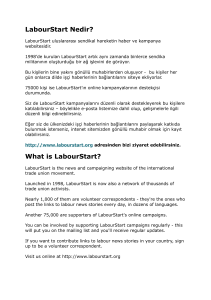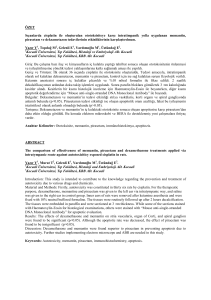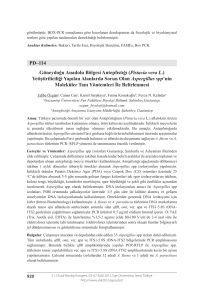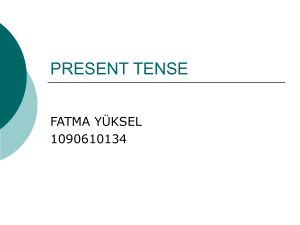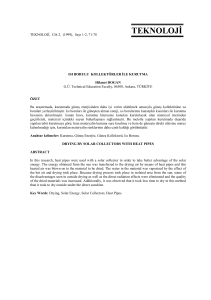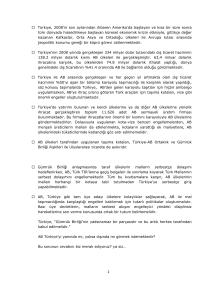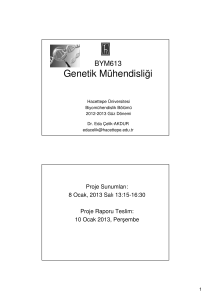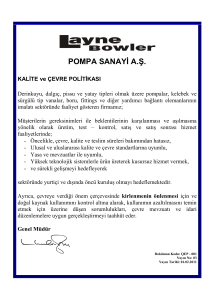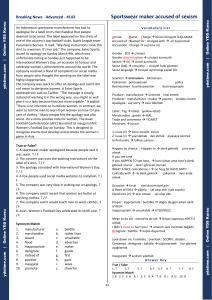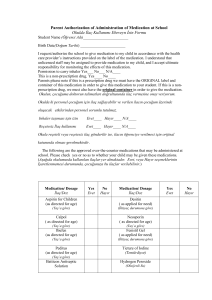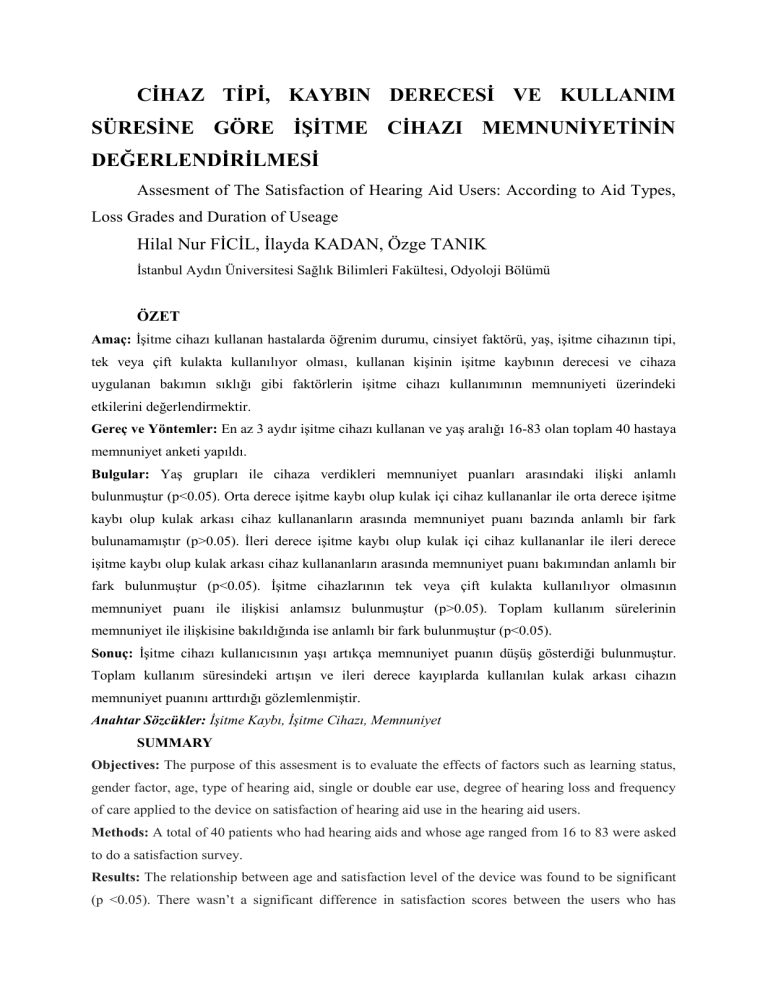
CİHAZ TİPİ, KAYBIN DERECESİ VE KULLANIM
SÜRESİNE GÖRE İŞİTME CİHAZI MEMNUNİYETİNİN
DEĞERLENDİRİLMESİ
Assesment of The Satisfaction of Hearing Aid Users: According to Aid Types,
Loss Grades and Duration of Useage
Hilal Nur FİCİL, İlayda KADAN, Özge TANIK
İstanbul Aydın Üniversitesi Sağlık Bilimleri Fakültesi, Odyoloji Bölümü
ÖZET
Amaç: İşitme cihazı kullanan hastalarda öğrenim durumu, cinsiyet faktörü, yaş, işitme cihazının tipi,
tek veya çift kulakta kullanılıyor olması, kullanan kişinin işitme kaybının derecesi ve cihaza
uygulanan bakımın sıklığı gibi faktörlerin işitme cihazı kullanımının memnuniyeti üzerindeki
etkilerini değerlendirmektir.
Gereç ve Yöntemler: En az 3 aydır işitme cihazı kullanan ve yaş aralığı 16-83 olan toplam 40 hastaya
memnuniyet anketi yapıldı.
Bulgular: Yaş grupları ile cihaza verdikleri memnuniyet puanları arasındaki ilişki anlamlı
bulunmuştur (p<0.05). Orta derece işitme kaybı olup kulak içi cihaz kullananlar ile orta derece işitme
kaybı olup kulak arkası cihaz kullananların arasında memnuniyet puanı bazında anlamlı bir fark
bulunamamıştır (p>0.05). İleri derece işitme kaybı olup kulak içi cihaz kullananlar ile ileri derece
işitme kaybı olup kulak arkası cihaz kullananların arasında memnuniyet puanı bakımından anlamlı bir
fark bulunmuştur (p<0.05). İşitme cihazlarının tek veya çift kulakta kullanılıyor olmasının
memnuniyet puanı ile ilişkisi anlamsız bulunmuştur (p>0.05). Toplam kullanım sürelerinin
memnuniyet ile ilişkisine bakıldığında ise anlamlı bir fark bulunmuştur (p<0.05).
Sonuç: İşitme cihazı kullanıcısının yaşı artıkça memnuniyet puanın düşüş gösterdiği bulunmuştur.
Toplam kullanım süresindeki artışın ve ileri derece kayıplarda kullanılan kulak arkası cihazın
memnuniyet puanını arttırdığı gözlemlenmiştir.
Anahtar Sözcükler: İşitme Kaybı, İşitme Cihazı, Memnuniyet
SUMMARY
Objectives: The purpose of this assesment is to evaluate the effects of factors such as learning status,
gender factor, age, type of hearing aid, single or double ear use, degree of hearing loss and frequency
of care applied to the device on satisfaction of hearing aid use in the hearing aid users.
Methods: A total of 40 patients who had hearing aids and whose age ranged from 16 to 83 were asked
to do a satisfaction survey.
Results: The relationship between age and satisfaction level of the device was found to be significant
(p <0.05). There wasn’t a significant difference in satisfaction scores between the users who has
medium grade hearing loss and using behind the ear aid and using in the ear aid (p>0.05). There was a
significant difference in satisfaction scores between the users who has high grade hearing loss and
using behind the ear aid and using in the ear aid (p<0.05). Using unilateral aid or bilateral aid is
unrelated with satisfaction scores (p>0.05). Finally, according to this assesment, there was a
significant difference between satisfaction scores and total duration of useage (p<0.05).
Conclusion: It has been found that as the age of the hearing aid user increases, the satisfaction score
decreased. We observed an increase in total using time and an increase in the satisfaction score of the
hearing aid behind the ear that was used in severe loss.
Key Words: Hearing Loss, Hearing Aid, Satisfaction

